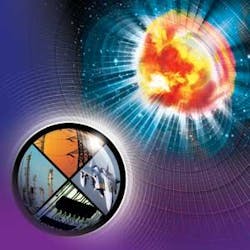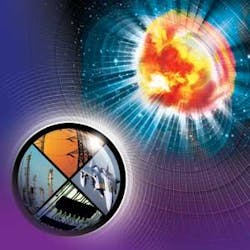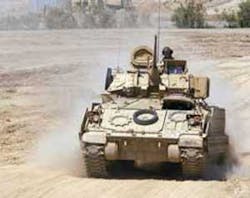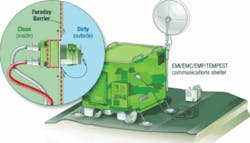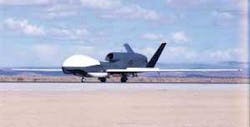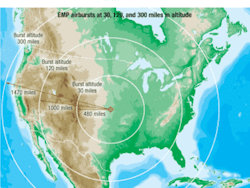Electromagnetic pulse, or EMP, poses a potential threat to life as we know it. Companies are beginning to offer better ways to shield military systems and critical infrastructure from these damaging rays.
By John Keller
What if an enemy of the United States could shut off the lights, computers, telephone networks, bank ATMs, factories, motor vehicles, and electric appliances in a large chunk of the continental U.S. with one surprise terrorist attack?
That could happen if a nation or terrorist group were able to acquire a nuclear-tipped missile, launch it from an apparently harmless freighter off the U.S. East Coast, and detonate it at an altitude as low as 80,000 feet over, say, Norfolk, Va. If this were to occur, there is a good chance the electric power grids would go down in an arc as large as from the Virginia/North Carolina border to Baltimore, and inland as far as Richmond.
That area would include the nation’s capital, Washington, D.C., as well as major military installations in the Hampton Roads area, such as Norfolk Naval Base, Fort Eustis, Langley Air Force Base, and Oceana Naval Air Station. Explode a nuclear device even higher, and that arc extends from Boston to Savannah, Ga., along the coast, and inland as far as Chicago.
“The higher up in altitude, the worse it is,” says Bill Magee, senior program manager for Transtector Systems, a manufacturer of electronic surge-protection products in Hayden, Idaho. “Explode a nuclear weapon 200 miles above Kansas City, and you can kiss off the power grids in all the United States. We’re back to being hunter/ gatherers.”
Such a scenario is not outside the realm of possibility. There was a time not so long ago when only the United States and Russia (as well as Russia’s predecessor, the Soviet Union) possessed nuclear weapons. The United Kingdom, France, and China joined the nuclear club in the 1950s and 1960s, and since then India, Pakistan, Israel, North Korea, and South Africa have developed nuclear weapons.
Iran is suspected of being close to developing a nuclear weapon. Of all the nations that have developed atomic warheads, only South Africa reportedly has destroyed its arsenal, but the know-how still exists in that country.
Iran and North Korea are declared enemies of the United States, and have missile systems of their own capable of delivering nuclear warheads. Both also have demonstrated their support for known terrorist groups like al-Qaida. Pakistan is not the most stable of states, and its long-term friendship with the U.S. remains a question mark. Suffice it to say that the threat of surprise nuclear attack on the United States only grows with time.
Electromagnetic pulse (EMP)
The culprit in these nightmare scenarios is called electromagnetic pulse –better known as EMP –which in addition to blast, intense heat, and radioactive fallout comprises the overall effect of an atomic explosion.
EMP is electromagnetic radiation typically from a nuclear explosion or an intensely fluctuating magnetic field that can infiltrate unshielded electrical and electronic systems to produce damaging current and voltage surges. Nuclear-caused EMP has three parts –E1, E2, and E3.
The E1 pulse is very fast, is high in frequency, and generates very high voltages. This E1 component of EMP can destroy or damage computers and communications equipment –even if components are not plugged in to an electrical source or antenna –because its high-frequency energy radiates across very short wires, such as those on printed circuit boards and small electronic components. The short duration of E1, measured in nanoseconds, is too fast for conventional lightning surge protectors to be effective.
E2 EMP energy, measured in tens or hundreds of microseconds, is akin to the energy from lightning, and is considered to be the easiest component of EMP to protect against. Lightning-protection components are common in electrical and electronic equipment, and can provide adequate protection from E2 EMP energy.
The E3 part of nuclear EMP is considered to be the most damaging because it lasts from tens to hundreds of seconds, travels long distances along power lines, pipes, and other long conductors, and can burn out almost everything connected to the power grid –including computers and data networks, telecommunications equipment, radios, televisions, and home appliances like electric range stoves and washing machines. E3 EMP energy also can destroy large power grid transformers that can be difficult and take a long time to replace; the E3 component of EMP that can take down the electric power grids by causing damage that could take six to 18 months to repair.
Aftermath of EMP attack
Consider a year without electricity all over North America. Some of the folks in the Northeast got a fleeting taste of how that might feel when an ice storm in early December caused widespread power outages that lasted a week or more (see “EMP attack rehearsal: living without power for nearly a week,” page 24). Still, the suffering of even those who endured the longest power outages before Christmas was virtually nothing compared to the human devastation that a sizable EMP attack could cause.
Fuel, food, and drinking water would disappear quickly –especially in the large cities; transportation and manufacturing would grind to a halt; cell phones and land lines would fall silent; little, if any, information would be available as the Internet would disappear; radio and TV stations would stop broadcasting, and newspapers and magazines would quit publishing; stores, restaurants, and hotels would be padlocked; hospitals would close; financial transactions would cease; the mail would stop; and companies would suspend business because their lights and machinery would not operate, and their employees could not get to work.
As weeks turned to months without electric power, there would be few jobs and fewer paychecks. What good is a paycheck, anyway, if all the banks and stores are closed, and there is no place to cash it?
For that matter, what good is cash if there’s no place to spend it? Hearty souls would resort to a centuries-old economy based on barter –assuming they had things of value to trade. Many –particularly in densely populated areas –would try to move to where things weren’t so bad, but they would not know where to go because of the information blackout. They might simply wander aimlessly for as long as they could.
Money, credit cards, even jewelry would be largely useless. On the other hand, fresh water, firewood, canned goods, meat and eggs, good knives, hand tools and lumber, medical supplies, blankets and warm clothing, sturdy shoes, fabric, needles and thread, candles, lamp oil, guns, and ammunition would be most highly valued. These commodities, along with coffee, liquor, and tobacco, likely would become the currency of the day.
By this time, most of the fuel would be gone, and most cars and trucks would be broken down from the EMP attack, so travel would be slow and difficult. Some might make their way to airports and train stations, only to find them closed and abandoned. People would have to stay where they were, make the best of what they had. Desperation, anguish, suffering, and despair would become common. Hearts would harden as families, groups, and individuals looked out only for their own.
With no cars on the roads, no planes in the air, no factories running, no TV, stereos, or iPods –and as the last working generator ran out of fuel and coughed to a stop –a profound silence would descend over the land that humans have not experienced in nearly 200 years. Then people would listen, intently, day and night, for any sound of encouragement or threat –shouting, an engine, a gunshot, hammers and saws, running water, someone playing an instrument. Mostly it would be quiet.
By the time months without electricity turned into a year, most of the very young and the very old would have perished. Many others would be gone, too. “With no power for a year, about 70 percent of the U.S. population dies from starvation,” says Charles Manto, president of Instant Access Networks (IAN) LLC, in Frostburg, Md., which provides systems and consulting to protect critical military and civil infrastructure from the effects of EMP.
In the United States one year after a serious and continent-wide EMP attack, all vestiges of the former high-tech economy would be only a memory; the population would be only one-third its former size; political institutions would be compromised, if not destroyed. Basically you’re looking at the aftermath of Hurricane Katrina on a national scale –or perhaps the Kansas Territory circa 1856.
Bear in mind that this scenario, dire though it sounds, only considers the disintegration of the electric power grid. What if pockets of the population somehow could generate their own electricity for the long term? It’s possible, especially with the advent of what people are calling “micro grids,” which describe power generation on a municipal scale with renewable energy sources like wind and solar power.
Islands of available electricity in a sea of devastation might mean that some folks could continue cooking, taking hot showers, conventionally heating their homes, and using electric lights. In those cases, however, procuring food would still be problematic; fuel availability would be spotty, at best; jobs would be scarce; communications would be sporadic; and transportation still a problem. Other areas of society would be similarly affected.
Congress formed the Commission to Assess the Threat to the United States from Electromagnetic Pulse Attack –better known as the U.S. EMP Commission –which published a detailed study last April. In addition to the electric power grid, the commission’s report considers the effects of EMP attack on telecommunications, banking and finance, petroleum and natural gas, transportation, food and water infrastructure, emergency services, space systems, government, and the psychological influences on the population. The commission’s report is available online at www.empcommission.org.
Without a functioning nationwide power grid, telecommunications would be hobbled, at best. Cell phone towers largely would not be able to function, network hubs might not be able to connect to one another. Most likely only islands of communications could be established, and of questionable reliability. An unreliable national telecommunications system also would take a toll on banking, transportation, energy, and public services.
Without a nationwide voice and data telecommunications system, the banking industry would be forced to fundamentally restructure and change the way banks do business. They would have to rely on paper transactions and may not have access to computer databases of deposits and withdrawals.
The impact on SCADA
Other public infrastructure like oil and gas, transportation, food, and water distribution also would be severely affected. The core reason for this would be EMP damage or destruction to electronic devices called supervisory control and data acquisition systems, otherwise known as SCADA.
These devices, along with digital control systems (DCSs) and programmable logic controllers (PLCs) comprise much of the computer control of critical infrastructure such as nuclear and other power generation, food processing, oil and natural gas pipelines, municipal water distribution, oil refineries, subways and rail transit, traffic signaling, and banking.
EMP has the potential to disrupt or destroy automatic digital control systems in critical industries like these. Worse yet, much of this critical infrastructure is interrelated such that a problem in one or more can have a ripple effect on others.
Say EMP damage disrupts telecommunications networks or power grids. “The technicians who show up, through the transportation infrastructure, to make repairs would not do so unless they have been sustained by the food and water delivery systems,” points out the most recent report of the U.S. EMP Commission.
In addition, loss of reliable digital control can compromise important safety systems and backups in oil refineries, nuclear power plants, oil pipelines, and other critical infrastructure, which in turn can cause even more extensive damage. A computer-controlled valve in a crucial section of an oil refinery, for example, could cause an explosion by failing to open or close at a given moment.
In the case of a refinery explosion, moreover, might automatic alarms damaged by EMP alert fire and rescue personnel? Might firefighters even be able to receive emergency calls if EMP had damaged the telecommunications and data networks? Might firefighters even be able to make it to work if EMP had damaged their cars or caused traffic gridlock because of malfunctioning traffic signaling? You get the idea.
What about the military?
The influence of EMP on critical military systems has been a consideration since the 1950s shortly after the atomic age began. These kinds of systems, such as warships and submarines, main battle tanks and other armored vehicles, jet fighters and military transport aircraft, as well as strategic weapons and communications systems, must meet the requirements of a variety of military and industry standards for EMP shielding and protection. These standards include MIL-STD-285, MIL-STD-188-125, MIL-STD-461E, MIL-STD-464, ANSI C95.3-1979, IEEE C63.14, and IEEE 299-1991.
In general, military and aerospace systems –especially those designed to go into combat or take part in strategic nuclear operations –are protected by shielding, surge protectors, hardened cabling, and other measures that systems designers can take to cancel or mitigate the effects of EMP.
The rising level in the use of commercial off-the-shelf (COTS) components and subsystems in military and aerospace applications over the past 15 years, however, is reason for military leaders to keep a close eye on the systems they deem to be crucial for continuing defense operations, and to ensure that programs for system testing are up to date.
Military forces also depend heavily on the commercial power grid for long-term operations, and a power grid failure could cause military problems of unknown severity.
Since the end of the Cold War in the early 1990s, civil and military officials have become relatively lax in their attention to EMP and EMP issues of influence to all systems. Moreover, in times of intense military operations, such as the current global war on terror, commercial-grade devices like personal global positioning system (GPS) navigation devices make their way to front-line troops.
It is an open question if these kinds of systems would fail at critical times in the wake of an EMP attack in the U.S. or overseas. Nevertheless, interest is increasing in EMP and EMP protection for military as well as civil infrastructure. “Over the last 10 years we have seen requests for EMP protection go up substantially,” says Scott Timms, president of EMP filtering specialist Captor Corp. in Tipp City, Ohio. “The U.S. recognizes that other countries have nuclear bomb capability, and we are hardening our systems to circumvent that.”
How to protect against EMP
Several companies in the U.S. and in Europe specialize in EMP protection for military and civil electronic systems. Instant Access Networks (IAN) LLC in Frostburg, Md., for example, is an EMP consultant and is designing portable shielded shelters for military, government, and civil use to protect crucial infrastructure like computers, data networks, and communications systems.
“Our goal is to create a mass-producible means to protect 10 percent of the critical infrastructure, the bulk of which is in local government or private hands,” says IAN president Charles Manto. “We are producing mass-producible modules for racks of computers, which are shielded on six sides, with super-surge protectors, and that fit in cargo containers.”
These portable rooms, which offer shielding not only on the walls, but also in cables, connectors, and antennas with electrical paths into and out of the shelters, are for critical municipal infrastructure like telecommunications and emergency communications. “We could place these shelters for emergency centers in rural areas outside of cities,” Manto explains. These EMP-hardened portable rooms most likely would have grid-independent power from renewable sources, such as wind and solar.
Engineers at Captor Corp. specialize in electronic transient protection modules primarily for EMP protection of military applications, Timms says. Captor’s transient protection modules integrate a transient device in addition to an electromagnetic interference (EMI) filter to reduce transient pulse. Also included are traditional filtering means, as well as Zener diodes.
“Our customers come to us and say ‘we have this system, and need to pass a mil-spec as far as EMP and EMI are concerned,’” Timms explains. “You have to put something on every line that penetrates that box, and protect every pin; everything that is exposed has to be shielded.
“Sometimes it is relatively simple, and other time it can be very costly,” Timms continues. “People might be able to get by with a transient device on each pin, and sometimes they may need additional filtering. It depends on what is in the box, and how sensitive it is to those EMPs.”
Generally speaking, it costs substantially more to retrofit an existing system with EMP protection than it is to design systems with EMP protection built in from the beginning, experts say.
“EMP protection does not just involve putting on a surge protector; it’s a total systems approach,” explains Magee of Transtector Systems, which specializes in custom transient protection filters for ground-based applications, and for AC power systems using electricity from the grid. The company is primarily involved in military applications. “It depends on the environment you deploy in, with Faraday shielding and cables that have to be hardened coming in and going out,” he continues. “When you start adding all multipliers, you can add a lot of cost –unless you are designing from the beginning.”
EMP attack rehearsal: living without power for nearly a week
By John Keller
“It’s a terrifying idea to think about an electromagnetic pulse (EMP) attack that brings down the nation’s power grids for as long as a year. On a grand scale it could mean two-thirds of the nation’s population dead, the economy eviscerated, political institutions gone, culture in ruins.
On a personal level, however, the potential effects are far more poignant. No lights. No water. No refrigeration. Difficulty cooking, cleaning, and bathing. Eventually it would mean scarce food and fuel, slow and difficult transportation, and frozen pipes. For many it would mean no heat, no ability to cook, and flooded basements.
I got a minute taste of what the aftermath of an EMP attack might be like just before Christmas when a severe ice storm in the Northeast United States cut off electricity to our home for six days. Many people had it worse. Some got power back just before the holiday.
The power went off in the middle of the night, as the ice storm raged outside, snapping branches, trees, and power poles, and popping power line transformers and circuit breakers with explosive booms. It sounded kind of like a war zone outside.
The first thing that hit when the power went off was disorientation and silence. The house went black except from the glow of the wood stove. No clocks were visible so I couldn’t tell what time it was. Nothing made a sound –not a refrigerator hum, no gurgling from the aquarium filter, no furnace rumble, no computer fan, nothing. Just silence inside, and the sound of the storm outside.
It was more difficult than I thought to flip a light switch and have only blackness. Since we have well and septic, no water came out of the faucets. To flush the toilet we needed a bucket of water –from somewhere. Fortunately we had filled some buckets the night before in anticipation of an outage. Just moving from room to room was difficult, as to do so safely I had to carry a candle or oil lantern.
Fumbling for matches in the dark was a frustrating, maddening, and sometimes painful ordeal. Fortunately we had plenty of firewood at hand, and a fireplace insert large enough to heat the house. The basement, however, was cold as a tomb, but fortunately not cold enough to risk bursting pipes.
I worried about having enough candles to last the duration of the outage. After a big EMP attack, I believe we would run out, and would have to be creative just to have any light at all.
One of the hardest things was simply the not knowing when the power might come back on. It was a relentless, grinding tension that rubbed tempers raw. In a real nationwide EMP attack, few, if any, radio and TV stations would be able to broadcast, so most people would have no word at all. Fortunately we have a hand-crank radio that enabled us to get word from outside in 30-minute intervals between cranking.
No power means everything you take for granted is hard to do. Without power for a long time, we might be faced with growing, preserving, and hunting for our own food, making our own clothing, hand-washing our clothes, and doing a lot of walking. I think we would have to get acquainted with farm animals pretty fast –if we could find any.
EMP is a serious threat, and one worth preparing for. That power outage in December really taught me a lesson.
